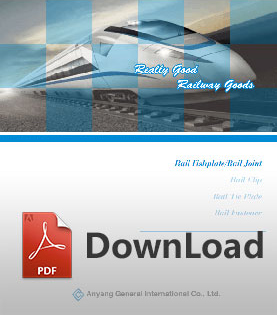What is a railway switch?

This is an informational post, please check the railroad switch page if you are searching for the product.
Railway switch, also known as railroad switch or rail turnout, is a connecting device in the modern railway systems. As an important component of track, railway switch is used to allow the train to switch tracks. Railroad switch has three basic forms: cross, connection, the combination of cross and connect. In general, railroad switch is wildly laid in the station and marshalling station. Railway switch has the characters of huge quantity, complex structure, short lifespan, speed limit, low-security, high maintenance cost, and etc. Railroad switch share the name of “three weak links of track” with railway curve and rail connection.
How does a railway switch work?
As we all know, railway switch can move train from one track to another one. How does a railway switch work? It is mainly completed by a component of railway switch- switch. Switch is a part that guide train in the main track or siding. The switch is composed of stock rails, switch ails, some connections parts and switch equipment.
The following image shows the working principle of switch. When the train run from trackway A to trackway B, operate switch machine to move the positon of switch rail, make switch rail 1 close contact with stock rail 1, and break away from stock rail2. So that trackway A is opened and track B is closed, then train run into connection part along lead curve to railroad switch frog and guide rail.
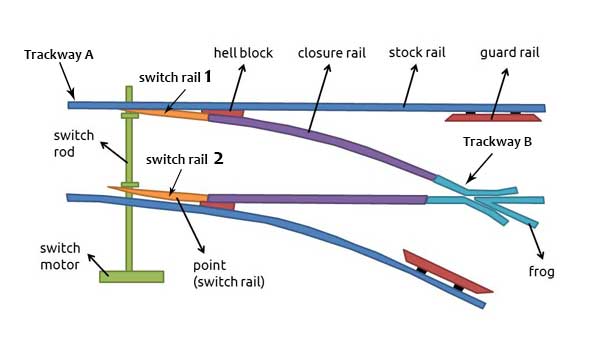
As for the switch operation, there are some differences between past time and modern time. In the past, switchman is the person who decides the moving direction of train. When the train need switch the railway, switchman operates the switch manually. Modern railway system is so automated that switchman is unnecessary. Instead, railroad man controls the railway switch electrically.
Types of railway switch
There are many kinds of railway switch, including simple turnout, equilateral turnout, three-way turnout and slip switch.
Simple turnout

The main track of simple turnout is straight line, the siding bifurcate from main track to left or right side. Generally, simple turnout is made up of switch, frog, guide rails and connection parts. Simple turnout has wide applications that reach 90% of all kinds of railway switch. There is a gap in the frog that limits the train speed. Movable-point frog is an effective way to increase the switch crossing speed.
Equilateral turnout

Equilateral turnout includes two roads bifurcate from main track to right and left. Parts of a railway switch arrange symmetrically lining the bisector of railroad switch frog angle. Two connecting rail have same curve radius, there is no difference in running conditions. Equilateral turnout has advantages in increasing radius of lead curve and shortening the length of station. Therefore, the equilateral turnout can be applied in the head or tail of switchyard. The equilateral turnout is also used with the simple turnout if necessary.
Three-way turnout

Three-way turnout refers to a turnout that bifurcates from main track to three different directions. It usually consists of a straight rail, two curve rails, two switch rails and three frogs. Three-way turnout is needed in the railway section that is limited by the topographical. Three-way turnout has an advantage of shorter length, but it has disadvantages like shorter useful life of switch, weaken switch rails and guide rails are missing. Normally, three-way turnout is used in the head of switchyard, stub-end station, and etc.
Slip switch
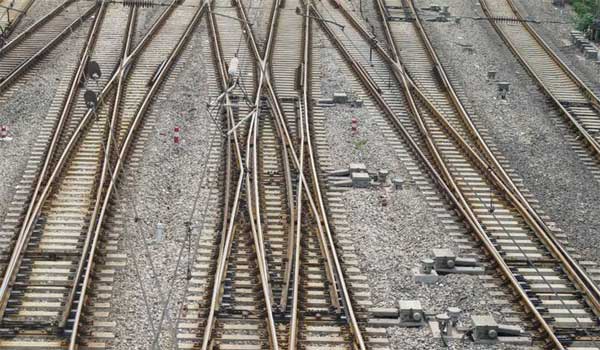
Slip switch means Group a simple turnout and another railway turnout. Slip switch include two types like single slip switch and double slip switch. Slip switch double the function of switch, and less ground demand. Besides that, less curve and smooth running is good for higher speed of train. Drawback of slip switch is more, such as complex structure, quantity components, and difficult maintenance. For the safety and maintenance, slip switch is rarely applied in the main track, it usually used in the marshalling station, passenger station and land restricted throat.
Railway switch help track give full play to its passing capacity. In a word, railway switch ensure the railway safety and reliability like other railway fasteners, such as rail joint, railway sleeper, rail clip, railway spike and etc.
- Rail Fasteners
- rail fastening system
- rail clip
- railroad spike
- Track bolt
- rail shoulders
- rail anchor
- rail clamp
- tie plate
- Rail Pad
- rail insulator
- rail plastic dowel
- other rail fasteners
- Railway Switch
- SKL series rail fastening system
- Chinese standard rail fastening system
- screw spikes
- Crane rail fastening system
- K type rail clip for Africa
- Hey-Back Rail Fastening
- rail fasteners for Mexican market
- Ss25 screw spike
- Ss35 rail sleeper screw spike
- Ss8 screw spike
- coach screw
- Crane Rail Clip
- Rail Joints (Fishplate)
- Steel Rail
- Railway Sleeper
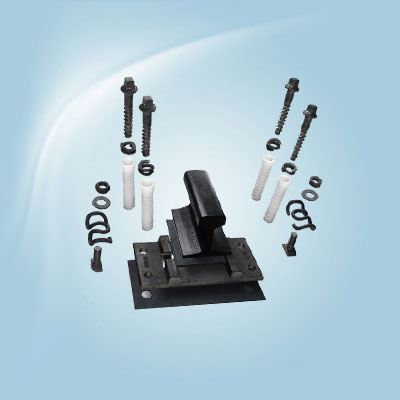 rail clip
rail clip
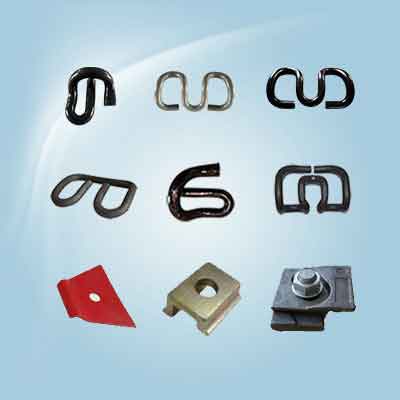 rail joints
rail joints

 Español
Español English
English
